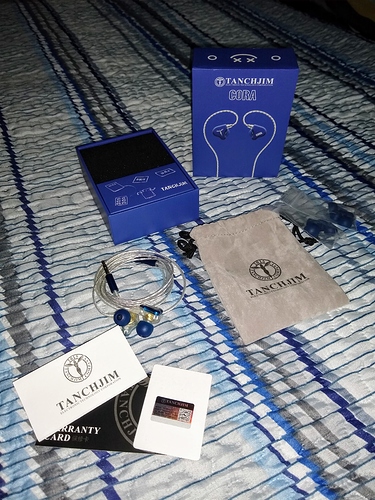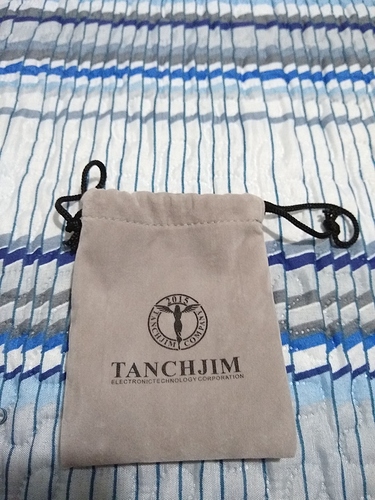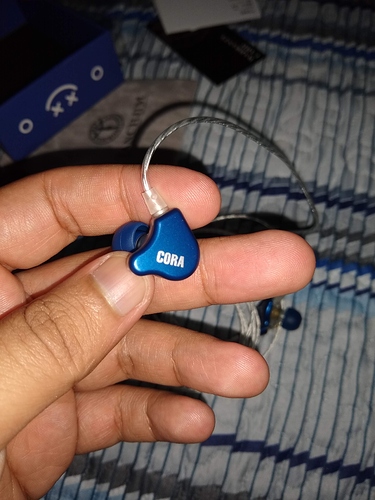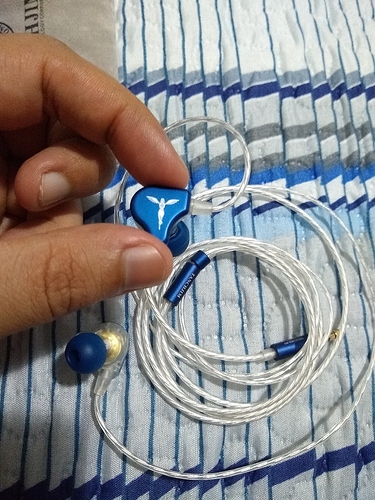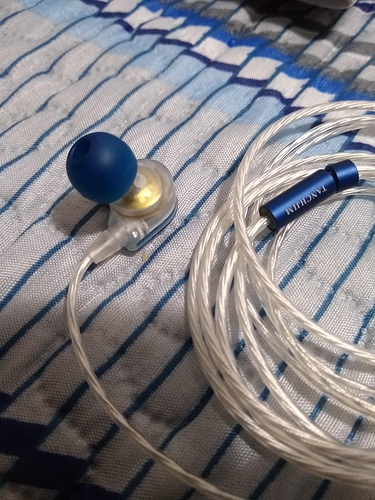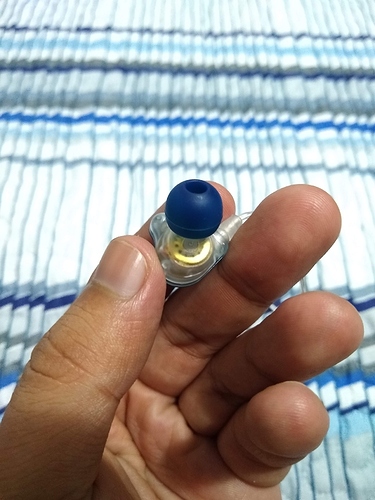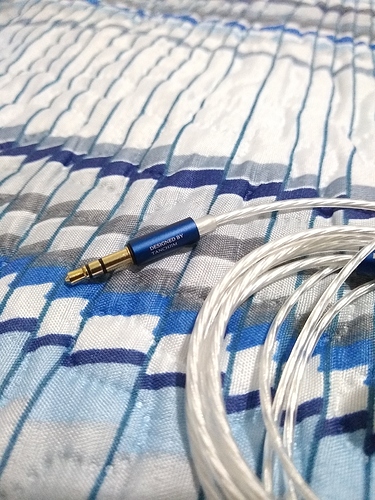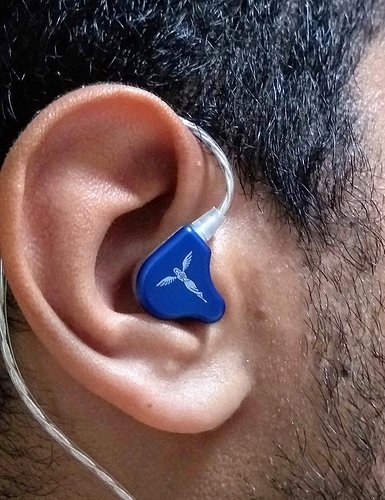I had the pleasure of knowing this wonderful IEM. So, I think it’s fair to share that with as many people as possible.
This topic is to discuss about the Tanchjim Cora. Feel free to post your impressions, review or make questions.
To begin with, here is my review:
REVIEW: TANCHJIM CORA
I am going to talk about this IEM, which, to me, is one more very convincing proof that quality isn’t always associated with price.
It is an IEM with 1 dynamic driver on each side, small size, very good build quality, and great ergonomics and comfort. And the main thing: an absurdly natural and correct sound.
Price: 49.90 USD.
ACESSORIES
The earphone comes in a small box, very well finished. Inside the box, there are some papers and cards from Tanchjim, a small pouch and two packages with Eartips on S, M and L. In one pack there are eartips of Rubber and in the other you will find the ones of silicone. The Eartips that already comes docked on the earphones are the silicone ones, on M size, and were the ones that fit better in my ears.
Another highlight goes to the quality of the pouch; it is velvety and soft, but very thick and sturdy.
BUILD QUALITY AND ERGONOMICS
In general, the build quality of Tanchjim Cora is very good. The IEM is quite small and the faceplates are made of painted aluminum with the brand symbols. The rest of the structure is made with a good quality semi-translucent plastic. Is possible to see the dynamic drivers (which are quite large in comparation with the IEM size) that are each covered by a metal plate (brass), which is “electrophoretic”, to reduce resonances, according to the manufacturer. I didn’t notice imperfections on the structure. Good Job by Tanchjim.
The cable is the same “High purity silver-plated OFC” that comes with the Tanchjim Oxygen. The only difference is that in the case of Cora it is fixed. For me, this is the only negative point regarding the cable. Despite this, I have only praise for the quality of the cable, even more for the price of the IEM. It looks very sturdy, is very well fixed to the earphones and presents very low, or no perceptible microphonics, depending of the type of use. When it comes to flexibility, it is not exceptional, but it has sufficient flexibility for good use and is difficult to tangle. An interesting point is that it doesn’t come with the typical Ear Hooks to fit behind the ear. It is the cable itself, which is partly moldable, that fits in on the back of the ear. Overall, it turns out to be a very practical cable.
Regarding ergonomics, again, i have only praise. Although not as good as the semi-custom HiFi Boy OS V3, for example, it took me a little time to find a good position to fit the parts with a good seal. The small size of the earphones also helps a lot in that regard.
EFFICIENCY
The Tanchjim Cora has 16 ohm impedance and 103 dB/mW sensitivity. It is therefore quite efficient, enough to play very weel on the majority of the smartphones out there. No difference was noted in the sound quality between it connected directly on the Samsung Galaxy S8 or using an amp (Fiio A5). Differences only in terms of volume.
SOUND
As some measurements show, the Tanchjim Cora follows Harman Target. Its sound signature is L-shaped: there is a slight emphasis on the bass, with the midrange and treble are perceptible on the same level of intensity (quantity).
The best word that could be used to describe the sonority of this IEM is “Natural.” The level of naturalness and realism of sound are amazing. All the instruments, voices and various others different sounds, are portrayed very correctly, as they really should be. All the frequency ranges are very well placed, with great balance, cohesion and without any kind of exaggeration or artificiality. It’s the kind of sound very pure, simple and honest, as you can find in a Headphone like the Sennheiser HD650 or the HD600.
Bass
The lows of the Tanchjim Cora are a little accented. It isn’t neutral in quantity, but is very well controlled. It is the type of bass that will never interfere in the other frequencies nor will be overly present when not needed.
The sub-bass has great presence, extension and and definition. There is no looseness on the Sub-bass; you can accurately perceive and easily distinguish it from mid-bass.
Regarding to mid-bass, it have a very well defined punch and, again, a lot of control. As I said in the Hifi Boy OS V3 review, they are of the type of bass that will give enough quantity for the listener to enjoy any musical genre without any exaggeration or deficiency. The transition from bass to midrange is flawless, I didn’t notice any interference in the mids.
Mids
For me, this is the best aspect of the sound of this IEM. The midrange of Tanchjim Cora is simply butterly, Pure and Beautiful. There is a lot of presence and linearity (neutrality) in this frequency region, but with a lot of control, without any exaggeration. What is most impressive is the extreme naturalness, fluidity and realism of this frequency range, both in terms of timbre and tonal balance.
There is no shouty mids, no spikes, nor hashness, no fatigue. On the other hand, there isn’t hollowness or dips on the this frequency range. Everything sound very, very correctly. Imagine a snare drum or an acoustic guitar being played in front of you. If you put the Tanchjim Cora in your ears and listen to the recordings (good recordings) of these instruments, the result will be very similar sounds and timbres. The same can be said for voices.
All the details are exposed very clearly, but only those that are actually brought by the recording. Do not expect the kind of sound with emphasis on the region (upper mids, mainly) to give the impression of extra/fake details. Again, It’s all about natural and organic, true sound.
Treble
The treble region of the Tanchjim Cora is also very correct. I terms of quantity, the treble is in line with the mids, also very neutral. There is no boost on the highs. On the other hand, in overall, I didn’t hear a roll off on this frequency region. The extension is also very good.
PS: About Extension, I have seen some people confusing Extension with Quantity; almost always they state that an IEM with a lower amount of treble has less extension in the region. Extension and quantity are two different things. Extended treble means having a wider range towards higher frequencies, which does not mean that the treble to be accentuated.
The details of higher-pitched instruments, such as snare drums, guitars, pianos, synths, are all heard with great clarity, naturalness and fidelity. However, as explained about the midrange, the detailing heard will be the extent provided by the recording. if there is any detail in the recording, the tanchjim cora will deliver, but without exaggeration, without fake detailing, all with a lot of control.
SOUND STAGE AND IMAGING
I found the Sound Stage of the Tanchjim Cora very “natural”, since it delivers the spatiality provided by the recording. Do not expect that artificial sensation of great spatiality, like and Open Back Headphone, for an example. On the Other Hand, there isn’t a feeling of claustrophobic sound. The Soundstage, in overall, is quite satisfactory.
The imaging is very good. There is a lot of precision and timing between the sounds delivered by the left handset and the right handset. In addition, the location of the instruments is also quite accurate.
COMPARISONS:
Sony MH1C
NOTE: Before doing this comparison, I have to make it clear that the Sony MH1C quality control is not good. I suspect mine is a bit treble and bass quantity than normal (which I realize from the various frequency graphs).
The Tanchjim and Sony sounds very similar, but with a few minor differences.
The MH1C Sub-bass region is a little more emphasized and loose than the Cora’s. In addition, it desn’t have the same level of precision, definition and control, although they are also very good.
The Mid-bass region is very similar, both in quantity and definition. Despite this, I feel a bit more punch on the Tanchjim Cora.
All the characteristics I referred to with regard to Tanchjim Cora’s Midrange can also be attributed to the Midrange of the MH1C. The difference is that I feel a little more presence and refinement on the mids of the Cora. The MH1C’s mids, although a little less present, are also a little more raw and aggressive, compared to the one of the Tanchjim. Despite this, I have to make it clear that MH1C isn’t aggressive, overall. These (very small) differences are perceived only in a direct comparison between these two IEMs.
Regarding the Treble, once again, they are quite similar in terms of timbre, definition and control. However, there is a bit more quantity on the Sony MH1C than the Tanchjim Cora.
In terms of Sound Stage and Imagin, both are very similar.
HiFi Boy OS V3
Both OS V3 and Cora have natural, relaxed and musical sonority. However, the OS V3 has a “darker” sound, while Cora is more correct, with no coloring.
The low-frequency region of these two earphones is very similar, both in terms of definition and extension. The difference here is that I feel a little more Sub-bass on the OS V3.
As for the Midrange, the OS V3 has slightly more “fat and dark” mids than the Cora. the HiFi Boy has a small increase on the low-mids, which give a little more weight to the region. In addition, it has a dip in the upper-mids region, which gives it a darker and more relaxed character to the midrange. The Tanchjim Cora, in comparison, has neutral, linear, mids without any peak, rise or dip on the region, which makes them more alive in comparison, but with the same refinement.
The treble of the two headphones are very similar, both have terms of extension, as well as timbre and quantity.
In terms of Sound Stage and Imaging, both are very similar.
Westone UM PRO 50.
NOTE: I do not have this IEM in hand, however, I listened to it exhaustively late last year for 3 days compared to the HiFi Boy OS V3 and I have a very clear memory of its sonority. The impression are based on this remembrance.
The sound of the UM PRO 50 is quite natural and relaxed, but darker (a little more than that of OS V3).
The Sub-bass of the PRO PRO 50 is lesser in quantity than the one of Cora, however, there is a similar definition in the region. On the mid-bass, the (very high) quality is also similar. However, I feel a little more punch on Cora’s, even for the fact that it uses a Dynamic Driver to produce bass, instead of BAs, like the UM PRO 50.
The midrange of the PRO PRO 50 has a small increase in the region of Low-mids, as well as the OS V3, which gives more weight to this frequency range. There is a dip in the upper-mids of the UM PRO 50, which makes the overall midrange darker, in comparison to the Cora’s one.
The Tanchjim, by having neutral mids, ends up having more life, realism and naturalness in this frequency region.
The treble are very similar in quality; but UM PRO 50 are a bit recessed in this region, while the treble of the Cora are more neutral in quantity.
In terms of Sound Stage and Imaging, they are also very similar, but with a bit advantage in spatially (sound stage) for the UM PRO 50.
CONCLUSION
It is impressive the sound that this IEM delivers for only 50 USD. Despite this, it is not news to me that price is not always synonymous with performance and that Marketing generates so much unconscious influence on people that it even changes their perception of sound. Not even expensive IEMs like the famous CA Andromeda impressed me as much as this IEM.
In my opinion, this is truly Hi-Fi sound (fidelity to the original recording), rather than what some “audiophiles” call Hi-Fi, which are sound signatures with boost on the high frequencies to artificially emphasize details.
Given the sound characteristics of the Tanchjim Cora: naturalness, realism, musicality, cohesion and its sound signature, overall, regardless of the price, THIS IS THE BEST IEM I EVER PUT IN MY EAR, until now.
I have a lot of curiosity and a certain expectation other IEMs that follow Harman Target, like Tanchjim Oxygen and Moondrop Kanas Pro, but, due to Cora’s already high quality, I don’t expect something much better (in terms of sound), maybe some small differences, despite the price.
SPECS:
Brand:TANCHJIM
Model: Cora
Driver: carbon diaphragm
Impedance:16Ω
Sensitivity:103dB/mW
Frequency response:10-40kHz
THD:<0.2%
Plug:3.5mmgold-plated straight plug
Package
TANCHJIM Cora
6 pais of silicone eartips
Pouch
